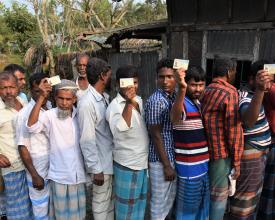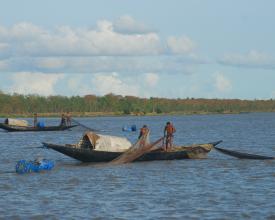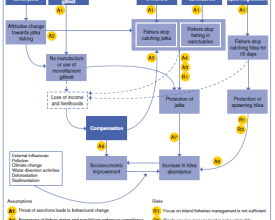
Gestion incitative de la pêche au hilsa au Bangladesh
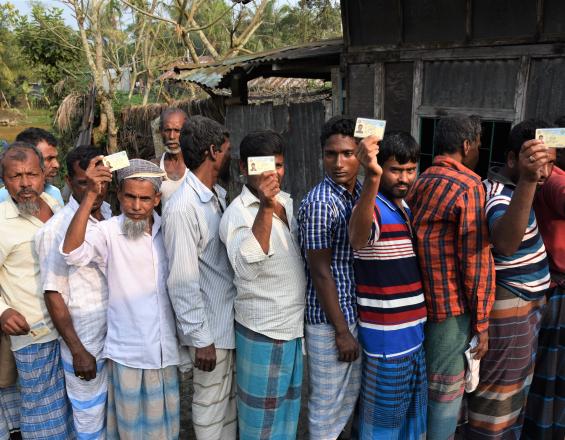
L'alose hilsa (Tenualosa ilisha) est le poisson national du Bangladesh. Elle assure la subsistance de plus de 500 000 personnes, en particulier dans les communautés côtières. Le département de la pêche du gouvernement bangladais utilise une gestion incitative pour protéger les stocks de hilsa. Dans le cadre du plan d'action pour la gestion de la pêche au hilsa, toute pêche est interdite plusieurs mois par an dans un certain nombre de sanctuaires côtiers et, pendant ces périodes, les ménages de pêcheurs concernés se voient offrir une compensation sous forme de riz afin d'améliorer leur sécurité alimentaire et de remplacer les revenus perdus. D'autres ménages touchés se voient proposer une formation et un soutien pour diversifier leurs sources de revenus. Associée à une cogestion adaptative et à des activités de sensibilisation aux pratiques de pêche durables, cette distribution de bénéfices vise à encourager le respect des règles de pêche et à améliorer la situation socio-économique des ménages de pêcheurs.
Contexte
Défis à relever
L'alose hilsa a une grande valeur économique, sociale et culturelle pour le Bangladesh. Dans les années 1970, la production de hilsa a progressivement commencé à décliner, principalement en raison de la surpêche et de la dégradation de l'habitat. Pour enrayer ce déclin, le gouvernement a introduit diverses réglementations en matière de pêche, y compris des interdictions saisonnières de pêcher - à la fois au niveau national et dans des zones spécifiques de sanctuaire du hilsa - dans le but de protéger les juvéniles et le frai du hilsa. Les pêcheurs artisanaux de hilsa connaissent généralement des niveaux élevés de pauvreté et de vulnérabilité, et ces règlements de pêche imposent donc un coût socio-économique, en particulier pour ceux qui vivent près des zones sanctuaires. Les capacités de contrôle et d'application des réglementations sont également limitées.
Emplacement
Traiter
Résumé du processus
Ensemble, la compensation alimentaire et le soutien à la génération de revenus alternatifs incitent au respect des réglementations relatives à la pêche au hilsa, en compensant le manque à gagner. En fin de compte, cette approche devrait conduire à une amélioration socio-économique des ménages de pêcheurs de hilsa et à une augmentation de l'abondance du hilsa.
Blocs de construction
Compensation alimentaire
Pendant les interdictions de pêche saisonnières, le gouvernement distribue des sacs de riz à une partie (environ 248 674) des ménages touchés dans 15 districts. Le programme a été introduit en 2004, dans le but premier de réduire l'insécurité alimentaire et la vulnérabilité, mais il incite également au respect des règles de pêche, en compensant le manque à gagner pendant les interdictions de pêche. Sur la base de recherches menées par l'Institut international pour l'environnement et le développement en partenariat avec le département des pêches du gouvernement du Bangladesh, le Centre d'études avancées du Bangladesh, l'Institut de recherche sur les pêches du Bangladesh et l'Université agricole du Bangladesh, le programme a été élargi et remanié pour renforcer son efficacité en tant qu'incitation économique. La couverture des ménages concernés a été multipliée par plus de sept depuis le début du programme, et les familles reçoivent désormais 40 kg de riz par mois pendant quatre mois, contre 10 kg initialement pour un à trois mois. Les cas de mauvaise répartition du riz ont également été réduits grâce à l'introduction de cartes d'identité pour les pêcheurs.
Facteurs favorables
Pour inciter au respect des règles, la compensation doit être jugée appropriée et suffisante pour compenser ou réduire le manque à gagner lié au respect des restrictions de pêche saisonnières. Elle doit donc être étayée par des recherches socio-économiques rigoureuses.
Le succès des mesures d'incitation dépend également de l'acceptabilité sociale, et il est donc essentiel de mener des activités de sensibilisation et de compréhension de la nécessité d'adopter des pratiques de pêche durables et de l'importance du respect des restrictions de pêche.
Leçon apprise
La compensation alimentaire peut avoir eu des conséquences négatives inattendues, notamment sur les prix du riz local, les marchés du travail et les marchés de la microfinance. Les programmes d'incitation devraient toujours étudier et tenter d'atténuer ces conséquences involontaires.
Il est également prouvé que les propriétaires terriens ont bénéficié d'avantages disproportionnés par rapport aux ménages de pêcheurs sans terre, les plus vulnérables, dont les revenus sont les plus faibles. Cette question met en évidence la nécessité pour les systèmes d'incitation inclusifs d'utiliser un biais systématique et positif en faveur de ceux qui en ont le plus besoin.
De même, les structures de pouvoir locales ont limité l'impact des compensations alimentaires accordées aux ménages de pêcheurs. La dépendance des pêcheurs à l'égard des intermédiaires pour l'obtention de crédits limite leur capacité à arrêter de pêcher pendant les fermetures saisonnières, car ils sont toujours tenus de rembourser leurs dettes.
Soutien à la création de revenus alternatifs
Depuis 2009, le gouvernement offre un soutien (par exemple, formation, cours de recyclage et microcrédit) pour aider les pêcheurs à générer des revenus à partir de moyens de subsistance alternatifs tels que l'élevage de bétail et les petites entreprises. Depuis 2015, WorldFish travaille avec le gouvernement pour améliorer cette approche dans des communautés sélectionnées à travers un projet appelé "Enhanced Coastal Fisheries in Bangladesh" (ECOFISH-BD). Par exemple, le projet a mis en place des groupes d'épargne communautaires (GEC) pour les femmes de ces communautés afin d'améliorer les comportements d'épargne des ménages de pêcheurs. Les membres reçoivent une formation sur l'éducation financière et l'importance de la gestion durable de la pêche au hilsa pour leurs moyens de subsistance et leur bien-être. Ils sont encouragés à épargner 100 BDT (un peu plus d'un dollar américain) chaque mois, et lorsqu'un CSG atteint un objectif d'épargne de 25 000 BDT, ECOFISH verse une somme équivalente. Cette mesure devrait inciter à épargner davantage et améliorer la situation socio-économique des ménages de pêcheurs, de sorte qu'ils soient plus à même de respecter les restrictions de pêche et de diversifier leurs moyens de subsistance.
Facteurs favorables
Le succès des incitations sous forme de soutien à la diversification des moyens de subsistance dépend de l'identification de types de soutien appropriés et socialement acceptables. Cela nécessite des évaluations rigoureuses et participatives des besoins et des préférences de la communauté.
Leçon apprise
L'aide gouvernementale à la création de revenus alternatifs a eu un succès et un impact limités en raison d'un manque initial d'engagement des parties prenantes et d'évaluation des besoins. ECOFISH-BD a remédié à cette situation en identifiant des types de soutien plus appropriés et en mettant en place les institutions locales et les systèmes de cogestion adaptatifs nécessaires pour soutenir la diversification des moyens de subsistance, mais il reste à voir si ces politiques et institutions survivront au-delà de la durée de vie du projet.
Il est également prouvé que les propriétaires fonciers ont bénéficié d'avantages disproportionnés par rapport aux ménages de pêcheurs sans terre, les plus vulnérables, dont les revenus sont les plus faibles. Cette question met en évidence la nécessité pour les systèmes d'incitation inclusifs d'utiliser un biais systématique et positif en faveur de ceux qui sont le plus dans le besoin.
Mesures réglementaires
Le gouvernement du Bangladesh gère la pêche artisanale du hilsa par le biais d'un certain nombre de mesures réglementaires, dont la plupart sont axées sur la protection des juvéniles :
- La pêche au hilsa est interdite dans tout le pays pendant la période de reproduction la plus intense (22 jours en octobre), afin de minimiser les perturbations du frai et du recrutement. L'application de la réglementation se concentre sur les zones connues pour être d'importantes frayères.
- La capture, la possession, la vente et le transport de hilsa juvénile (alevins de moins de 25 cm de long) sont interdits pendant huit mois dans tout le pays, entre novembre et juillet, afin de maximiser le recrutement des juvéniles dans la pêcherie. L'application de cette interdiction se concentre sur 7 000 kilomètres carrés de zones côtières, estuariennes et fluviales.
- L'utilisation et la production de filets maillants en monofilament sont interdites toute l'année, toujours pour protéger les juvéniles de hilsa.
- Six sanctuaires de hilsa ont été désignés pour protéger les principales zones de reproduction du hilsa. Ces sanctuaires s'étendent sur des tronçons de rivière de 20 à 100 km. Toute pêche est interdite pendant au moins deux mois dans ces zones pendant les périodes de pointe de la présence des juvéniles.
Une équipe de "tribunaux mobiles" opère au niveau du sous-district pour faire respecter ces règlements, avec le soutien de la police et d'autres agences.
Facteurs favorables
L'efficacité du contrôle et de l'application des réglementations en matière de pêche repose sur des ressources humaines, physiques et financières, mais celles-ci sont limitées au Bangladesh. En lieu et place d'un suivi et d'une application appropriés, l'octroi de compensations permet aux pêcheurs de se conformer à ces réglementations et les incite à le faire en compensant ou en réduisant les coûts socio-économiques.
Leçon apprise
Pour avoir un impact positif sur les stocks de hilsa, les règlements doivent s'appuyer sur des recherches écologiques et biologiques solides. L'emplacement géographique et les calendriers saisonniers des règlements conçus pour protéger le hilsa ont été adaptés au fil du temps en réponse à de nouvelles preuves scientifiques.
Impacts
L'approche de gestion basée sur les incitations a eu un impact socio-économique direct sur les communautés de pêcheurs de hilsa au Bangladesh. Au moins 248 674 ménages de pêcheurs ont reçu 20 à 40 kg de riz par mois pendant les interdictions de pêche. Un plus petit nombre de ménages ont bénéficié d'un soutien à d'autres moyens de subsistance, dont il a été démontré qu'ils entraînaient des gains significatifs en termes de revenus et d'actifs.
Les recherches suggèrent que cette approche de gestion a contribué à une augmentation de la production de hilsa de plus de 100 % au cours des 15 dernières années, ce qui indique une augmentation de l'abondance du hilsa. Cette augmentation de la productivité a également profité aux pêcheurs de hilsa par le biais d'une augmentation des revenus de la pêche. Bien qu'il soit difficile d'évaluer l'impact supplémentaire des mesures d'incitation au respect des règlements de pêche par rapport à l'utilisation des seuls règlements, il semble probable que les mesures d'incitation aient contribué à une réduction de la pêche dans les sanctuaires pendant les périodes d'interdiction. Les activités de sensibilisation ont probablement renforcé cet impact.
Cependant, les preuves d'une augmentation de la productivité sont variables dans l'espace, ce qui suggère que des changements environnementaux défavorables pourraient masquer ou contrebalancer les avantages de la gestion dans certaines zones. Il est également prouvé que l'aide alimentaire et financière n'atteint pas toujours les pêcheurs les plus vulnérables ou n'aide pas suffisamment ceux qui sont coincés dans des cycles d'endettement.
Bénéficiaires
Les bénéficiaires directs de cette approche de gestion sont les ménages des communautés de pêcheurs artisanaux de hilsa dans 15 districts du Bangladesh. Indirectement, tous les pêcheurs de hilsa bénéficient de cette gestion, y compris les opérateurs industriels.
Objectifs de développement durable
Histoire
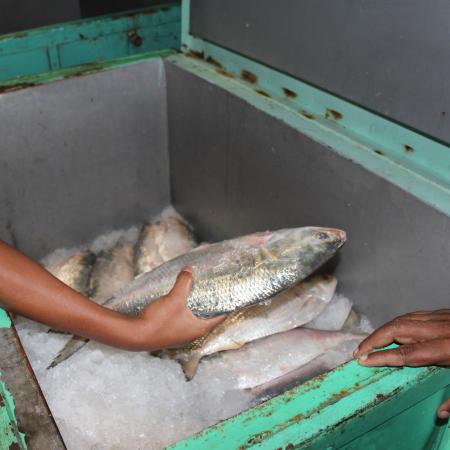
Lorsque le gouvernement du Bangladesh a commencé à distribuer des compensations aux pêcheurs de hilsa en 2004, la participation de la communauté a été très faible et l'impact limité. En avril 2013, l'Institut international pour l'environnement et le développement (IIED) a lancé un projet de quatre ans visant à repenser l'approche par le biais d'une recherche socio-économique et écologique rigoureuse et d'une collaboration avec le département des pêches du gouvernement du Bangladesh. L'IIED s'est associé au Centre d'études avancées du Bangladesh et à l'Université agricole du Bangladesh, et le projet a été financé par l'initiative Darwin du gouvernement britannique.
En établissant très tôt des relations de confiance avec des responsables gouvernementaux de haut niveau et en travaillant avec un groupe diversifié de parties prenantes, les chercheurs ont montré au gouvernement comment il pouvait améliorer son approche et la rendre plus efficace, plus efficiente, plus équitable et plus durable. Ils ont également démontré que la modification de l'approche pouvait avoir des avantages économiques, sociaux et écologiques. En conséquence, le gouvernement s'est engagé à étendre la couverture des mesures d'incitation, à prolonger la période d'engagement et à augmenter le montant de l'aide apportée aux pêcheurs et aux pêcheuses.
Le succès de ce projet a influencé la mise en œuvre conjointe par le Département des pêches et WorldFish d'une initiative quinquennale (2014-2019) financée par l'USAID, appelée "Enhanced Coastal Fisheries in Bangladesh (ECOFISH-BD)", dont l'objectif global est d'améliorer la résilience de l'écosystème de la rivière Meghna et des communautés qui dépendent de la pêche côtière au Bangladesh. Un élément clé de ces efforts a consisté à soutenir l'accès des femmes aux ressources et aux technologies pour la diversification des moyens de subsistance et l'amélioration de la résilience des communautés pendant les périodes d'interdiction de la pêche.
Ensemble, ces initiatives ont renforcé l'approche incitative utilisée au Bangladesh en réduisant les difficultés imposées aux communautés de pêcheurs vulnérables et ont contribué à une augmentation significative de la productivité de la pêche au hilsa dans tout le pays.
